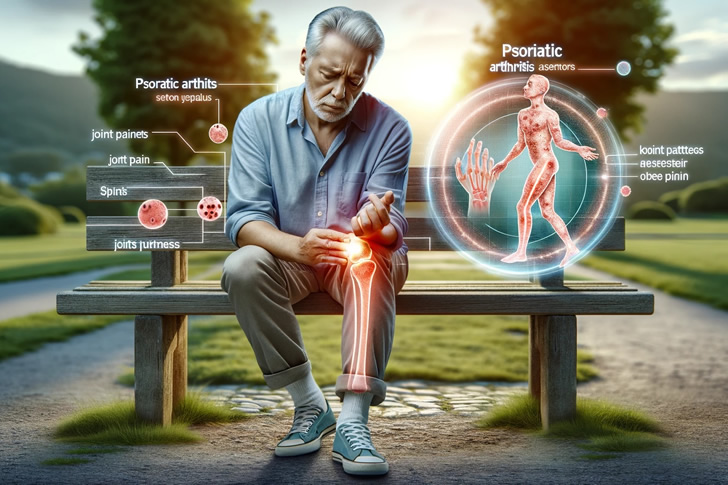Unraveling the Mystery of Psoriatic Arthritis: What Experts Want You to Know
Psoriatic arthritis is not just a skin condition; it’s a complex inflammatory arthritis affecting joints and entheses.

Introduction
Psoriatic arthritis (PsA) is a chronic autoimmune disease characterized by both psoriasis and joint inflammation. It affects approximately 30% of individuals with psoriasis, translating to millions worldwide. This article dives into the causes, early symptoms, and current treatments of PsA, with a focus on understanding this multifaceted condition and providing practical advice on management, including insights into natural remedies and specialized care for seniors.
Common Psoriatic Arthritis Causes
Genetic and Environmental Factors
Psoriatic arthritis results from a combination of genetic predispositions and environmental triggers. Genes associated with immune response, like HLA-B27, significantly increase the risk. Environmental factors such as infections, physical trauma, and stress can trigger or exacerbate the condition.
Immune System Dysfunction
The immune system plays a crucial role, particularly the improper activation of T cells and the resulting overproduction of inflammatory cytokines such as tumor necrosis factor (TNF) and interleukin-17 (IL-17), which lead to joint inflammation and skin lesions.
Early Hints of Psoriatic Arthritis
Identifying PsA early can significantly improve management outcomes. Early symptoms often include:
- Joint pain and swelling: Typically in the fingers and toes, which may appear sausage-like.
- Morning stiffness: Prolonged stiffness in the joints and around the tendons.
- Nail changes: Pitting, thickening, or separation from the nail bed.
- Reduced range of motion: Difficulty with movement as inflammation progresses.
Recognizing these symptoms promptly can lead to earlier diagnosis and treatment, potentially slowing the disease’s progression.
What Does Psoriatic Arthritis Look Like?
Psoriatic arthritis presents in various forms, ranging from mild to severe. It can involve:
- Asymmetric oligoarthritis: Affecting different joints on each side of the body.
- Symmetric polyarthritis: Resembling rheumatoid arthritis with the same joints affected on both sides.
- Distal interphalangeal predominant (DIP): Involving the joints closest to the nail in fingers and toes.
- Spondylitis: Affecting the spinal column.
- Enthesitis: Inflammation at sites where tendons or ligaments insert into bones.
Visual symptoms include swollen and tender joints, often with overlying red, scaly skin patches characteristic of psoriasis.
New Treatments for Psoriatic Arthritis
Biologics
Biologics have transformed PsA treatment by targeting specific parts of the immune system. Medications like TNF inhibitors (adalimumab, etanercept) and IL-17 inhibitors (secukinumab, ixekizumab) have shown great efficacy in reducing joint inflammation and skin symptoms.
JAK Inhibitors
Recently, Janus kinase (JAK) inhibitors, such as tofacitinib, have been approved for PsA. They work by blocking the signaling pathway important for the immune response in psoriatic arthritis.
Ongoing Research
Research continues into more targeted therapies, including new biologics and small molecule medications that can offer relief with fewer side effects.
Natural Remedies for Psoriatic Arthritis
While not replacements for conventional treatments, certain natural remedies can complement them:
- Omega-3 fatty acids: Found in fish oil, they can help reduce joint inflammation.
- Turmeric: Contains curcumin, known for its anti-inflammatory properties.
- Physical therapy: Helps maintain joint function and reduce stiffness.
- Acupuncture: May provide pain relief for some patients.
- Stress management techniques: Such as yoga and meditation, which can help manage flare-ups.
Psoriatic Arthritis Causes and Treatments in Seniors
In seniors, PsA must be managed with an eye on comorbidities and the increased risk of medication side effects. Treatment regimens often require adjustments, emphasizing tolerability and patient-specific factors such as existing cardiovascular disease or diabetes. Regular monitoring and a comprehensive approach are crucial to balance efficacy with safety.
Living with Psoriatic Arthritis
Lifestyle Adjustments
Managing PsA effectively also involves lifestyle modifications. Regular exercise helps maintain joint function and reduce stiffness, while a balanced diet can help manage weight and reduce strain on joints. Stress reduction techniques such as yoga, meditation, or mindfulness can also be beneficial, as stress can exacerbate symptoms.
Patient Education
Education is a critical component of managing PsA. Patients who understand their condition and treatment options are more likely to comply with treatment regimens and report better outcomes. Support groups and resources from organizations like the National Psoriasis Foundation can provide valuable information and support.
Conclusion
Psoriatic arthritis is a serious condition that demands a sophisticated approach to diagnosis and treatment. Understanding its causes and recognizing early signs are vital for effective management. With advancements in medical treatments and the integration of supportive natural remedies, individuals with PsA can lead active, fulfilling lives. Continued research and patient education remain key to navigating this challenging disease, especially for seniors who require more nuanced care strategies.







Recent Comments